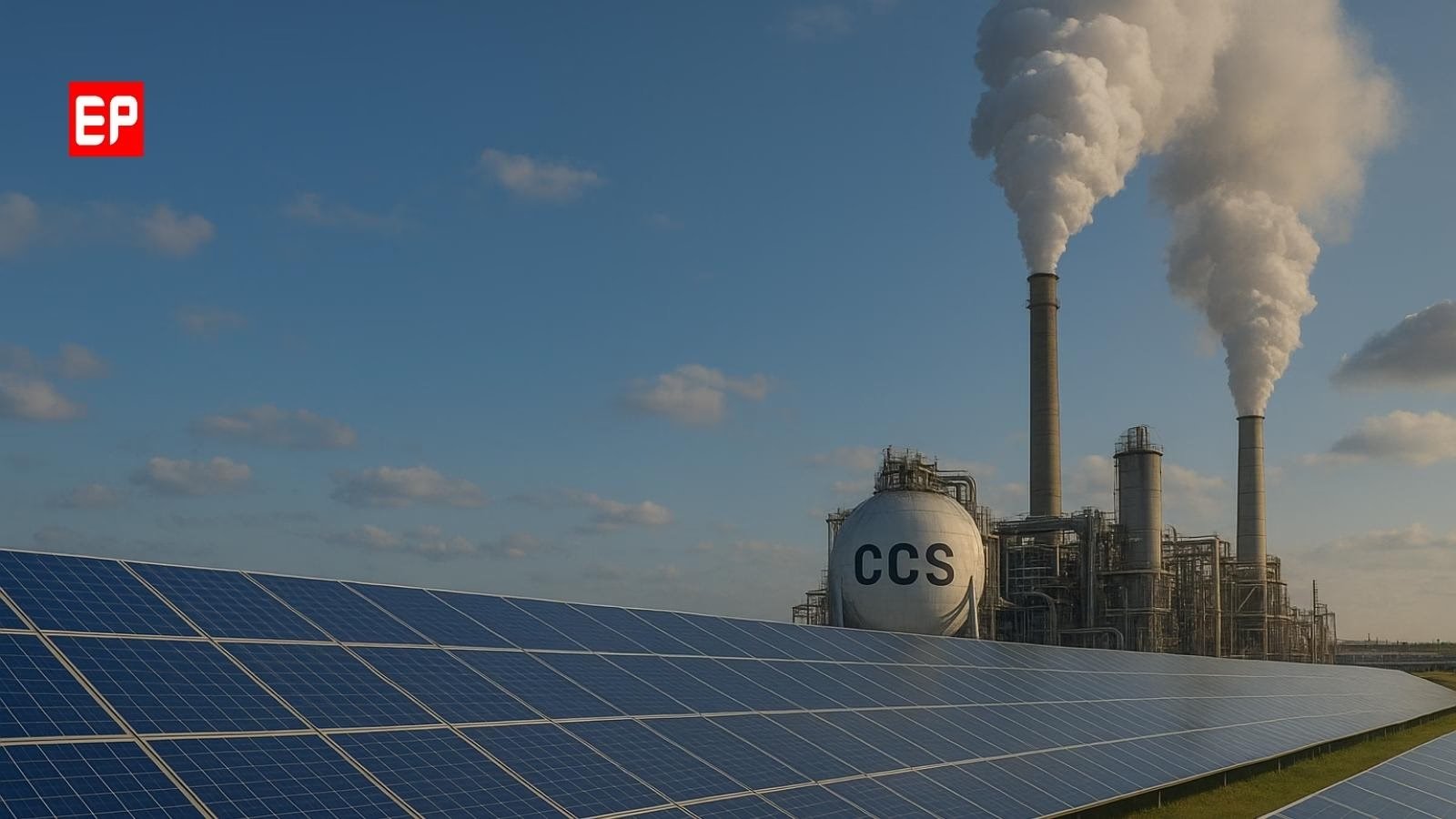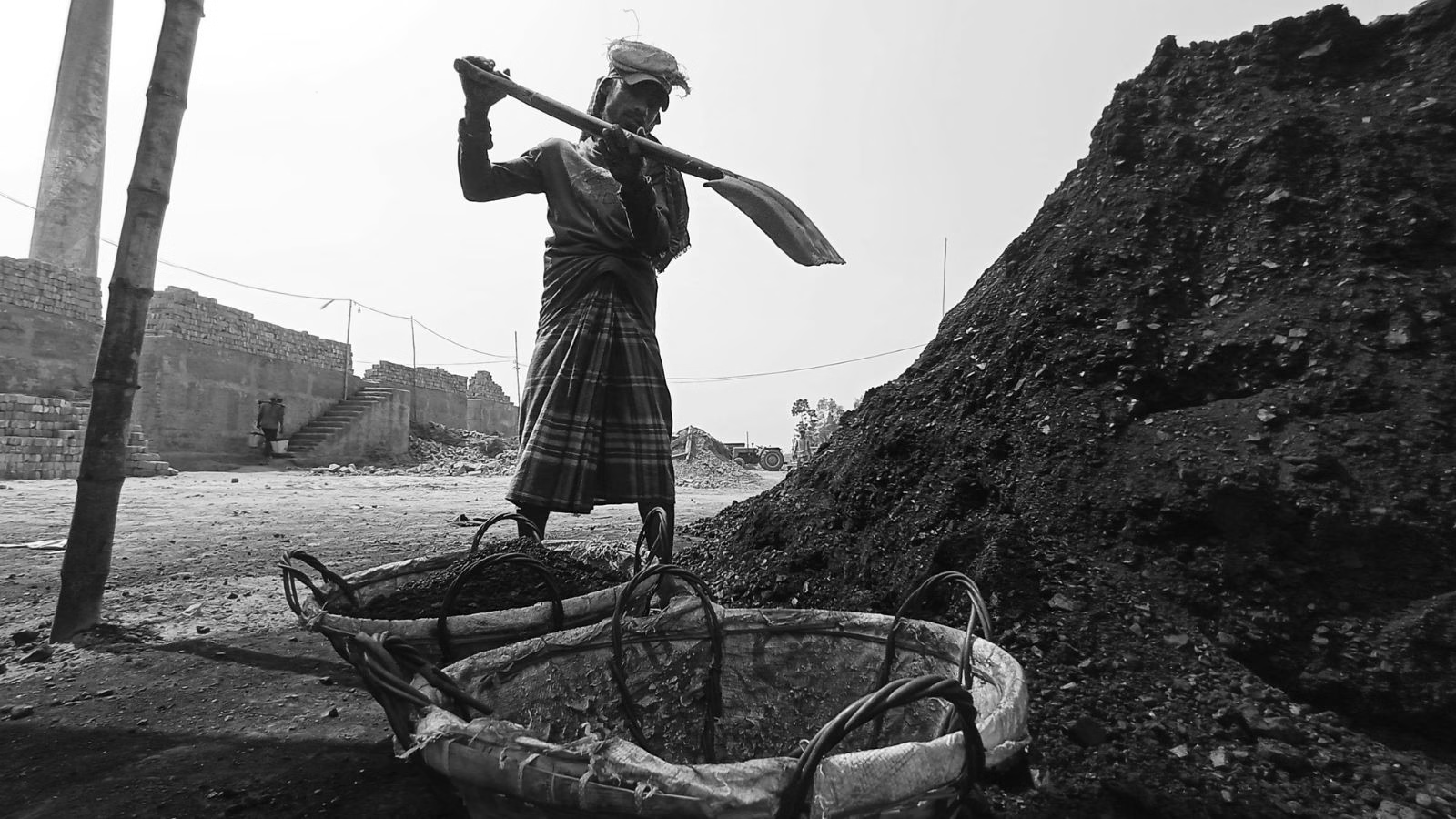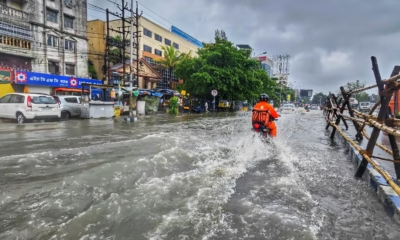Sustainable Energy
India’s Carbon Capture Push Could Risk Climate Goals, Warns New Report
India’s CCS plans could undermine its climate goals, says Climate Analytics, urging focus on renewables, storage, and decentralised clean energy.

India’s growing interest in carbon capture and storage (CCS) could undermine both its net-zero ambitions and the Paris Agreement, according to a new report from global science and policy institute Climate Analytics. The analysis warns that if Asian countries, including India, pursue a high-CCS pathway, the region could generate an additional 25 billion tonnes of greenhouse gas emissions by 2050, threatening to derail the global 1.5°C target.
The report, “The Global Climate Risks of Asia’s Expansive Carbon Capture and Storage Plans”, evaluated CCS deployment across key Asian economies including China, India, Japan, Korea, Indonesia, Thailand, Malaysia, Singapore, and Australia, which together account for more than half the world’s fossil fuel and greenhouse gas emissions
“We find a strong possibility that Asian countries could increase their support for CCS through to 2050, risking a significant lock-in of unabated fossil fuels and stranded asset costs, let alone risks to the world achieving the Paris Agreement 1.5˚C warming limit,” said report lead author James Bowen, an analyst at Climate Analytics
India’s CCS Dilemma
India is currently developing a National Carbon Capture, Utilisation and Storage (CCUS) Mission, which aims to explore technology pathways to decarbonise hard-to-abate sectors such as steel, cement, and fertiliser. However, the Climate Analytics report cautions that turning too decisively toward CCS could prove counterproductive.
It warns that if India and China “turn more decisively to future CCS dependence, it could have disastrous climate results,” as most CCS systems currently capture around 50% of emissions — far below the 95% needed to qualify as genuinely abated.
India’s CCS ambitions come at a time when its renewable energy sector is witnessing unprecedented growth. The country has already achieved over 190 GW of installed renewable capacity, including solar (88 GW), wind (47 GW), and hydropower (47 GW), and is targeting 500 GW of non-fossil capacity by 2030. According to the International Renewable Energy Agency (IRENA), India’s renewables are already among the cheapest in Asia, with utility-scale solar power generation costs at below ₹2.5 per kWh, far lower than coal or CCS-backed power.
Renewables: India’s Stronger Bet
“Deploying CCS in the power sector is, at the global average, estimated to produce a levelised cost of electricity up to at least twice that of renewables backed by storage,” the report notes
This data resonates with India’s policy shift toward decentralised clean energy. The Ministry of New and Renewable Energy (MNRE) has been driving large-scale solar park schemes while also supporting decentralised renewable energy (DRE) initiatives — from rooftop solar to community-based mini-grids — that directly power rural households, schools, and local enterprises.
Decentralised renewables are already reshaping India’s energy access landscape. According to the Council on Energy, Environment and Water (CEEW), over 100 million rural Indians could benefit from DRE systems by 2030, creating new livelihood opportunities while cutting dependence on fossil fuels. These systems also reduce transmission losses and strengthen energy security — areas where CCS offers no advantage.
Economic and Climate Risks
The Climate Analytics report argues that CCS in Asia poses both climate and economic risks. In India’s context, CCS could divert valuable capital away from sectors where renewable and electrification technologies are rapidly maturing.
“Fossil fuel energy and industrial installations with CCS are becoming increasingly uncompetitive against more economic, cheaper and more sustainable mitigation options such as renewable energy coupled with storage and electrification,” said Bowen
‘A Crossroads Moment’
Bill Hare, CEO of Climate Analytics, described Asia’s approach to CCS as “a very risky strategy, not only to the Paris Agreement, but to these economies themselves.” He added, “Asia is at a crossroads: while these countries haven’t yet gone down a high CCS route, many have tailored their CCS policies to protect their fossil fuel industry, especially in Japan, South Korea and Australia.”
For India, the choice between CCS and renewables may define its clean energy decade. Experts note that doubling down on renewables, storage, and electrification — supported by decentralised energy models — would yield faster, cheaper, and more reliable results than investing in unproven, capital-intensive CCS systems.
If India’s energy transition maintains its renewable momentum, it could become a model for the “deliberate low-CCS pathway” that Climate Analytics recommends — one that aligns with both economic pragmatism and climate responsibility.
Earth
India and China to Peak Coal Emissions by 2030 — and India’s Data Proves It’s Economically Inevitable
New analysis finds China, India, and Indonesia—the world’s top coal users—can peak power-sector emissions by 2030, marking a global climate turning point.

In what could mark a historic global energy shift, new analysis from the Centre for Research on Energy and Clean Air (CREA) reveals that the world’s three largest coal growth markets, China, India, and Indonesia, are on track to peak their power sector emissions by 2030. Together, these nations accounted for a staggering 73% of global coal consumption in 2024, making this potential turnaround a defining moment in the fight against climate change
China: Clean Energy Outpaces Demand
China has already reached a milestone that once seemed improbable: clean energy growth has outpaced the rise in electricity demand, leading to a fall in coal power emissions since early 2024
In 2024 alone, the country added 277 GW of solar capacity and 80 GW of wind, with an additional 212 GW of solar in just the first half of 2025. “Since I announced China’s goals for carbon peaking and carbon neutrality five years ago, China has built the world’s largest and fastest-growing renewable energy system,” President Xi Jinping declared earlier this year.
If current trends continue, China’s coal use may never return to previous highs. But sustaining this progress depends on meeting its 2035 clean energy targets and avoiding a slowdown in installations.
“China has already added enough new clean electricity generation to cover all new demand growth, and power sector coal use and emissions have been falling since 2024 as a result,” said Lauri Myllyvirta, CREA’s Lead Analyst, in the report.
India: Rapid Clean Energy Expansion Takes Off
India’s clean electricity boom, once stalled, has roared to life. In 2024, the country added a record 29 GW of non-fossil capacity, and by mid-2025, that pace had surged by 69% year-on-year.
With Prime Minister Narendra Modi’s 500 GW clean power target by 2030, India is already more than halfway there. The nation’s growing domestic solar manufacturing base—118 GW of module capacity and 27 GW of solar cells—is transforming it into a global solar hub.
“Meeting India’s 500 GW non-fossil power capacity target could peak coal power before 2030,” said Manoj Kumar, CREA Analyst. “Strengthening grid flexibility, storage, and transmission will be key to sustaining this momentum.”
India’s Coal Economics Have Flipped
A new report from Ember (October 2025) adds powerful economic validation to CREA’s projection.
Titled “Adding coal beyond the National Electricity Plan 2032 targets is uneconomical for India,” Ember’s findings confirm that building more coal plants is no longer cost-effective or necessary.
Ember’s least-cost operations model shows that if India meets its National Electricity Plan (NEP) 2032 targets for renewables and storage:
- 10% of new coal units built after FY2024–25 will be completely unutilised by 2031–32
- 25% of the coal fleet will be heavily underutilised
- Coal-based electricity will become 25% more expensive by 2031–32 as utilisation drops
“Building coal beyond the current pipeline is neither necessary nor economical for the country,” said Neshwin Rodrigues, Senior Energy Analyst at Ember.
Ember’s study aligns with CREA’s broader conclusion — India’s clean energy growth is not only sufficient to meet new demand but also the cheapest and most reliable path forward.
Indonesia: Big Solar Vision vs. Fossil Reality
Indonesia’s new president Prabowo Subianto has laid out a bold plan for 100 GW of solar capacity and a 100% renewable power system by 2035. If fully realized, this initiative alone could cause coal power to peak by 2030.
However, Indonesia’s official power plan—the RUPTL 2025–34—still leans heavily on new coal and gas plants. CREA’s analysis warns that without strong oversight and power market reforms, Indonesia’s solar revolution could stall.
“The real opportunity lies in translating this vision into a concrete delivery roadmap that positions clean energy to dominate new capacity additions,” said Katherine Hasan, CREA Analyst.
The Economics of Change
Across all three nations, clean energy’s economic edge is becoming undeniable.
The cost of solar panels has dropped 60% since 2022, while battery storage prices fell 50% between 2022 and 2024. In China, clean energy industries now make up over 10% of GDP, fuelling jobs and innovation. India’s solar bids are now cheaper than coal tariffs, and Indonesia’s strong sunlight potential could soon make solar the most cost-effective option for households.
CREA’s report also highlights that these clean energy drives align with national priorities: energy independence, industrial growth, and improved air quality.
A Common Threat: Coal’s Last Stand
Despite rapid progress, the report warns of a looming obstacle—new coal projects. China currently has 230 GW of coal-fired power under construction, and India plans 100 GW more by 2035. “Unchecked coal power expansion risks creating powerful vested interests that could delay the energy transition,” Myllyvirta cautioned. A rapid phase-down post-2030, he added, could cut emissions equivalent to India’s entire 2019 CO2 output.
A Turning Point for BRICS and the Planet
If successful, China, India, and Indonesia would join Brazil, South Africa, the UAE, and Ethiopia—other BRICS members that have already peaked their power emissions—transforming the bloc into an unexpected climate leader.
But the next few years are pivotal. Whether these nations sustain their clean energy momentum or fall back into fossil dependence could determine the world’s ability to meet the goals of the Paris Agreement.
As CREA concludes in the report, the road to peaking emissions is now open—what remains is the political will to walk it.
Sustainable Energy
Gujarat, Kerala Top India’s Rooftop Solar Race as PMSGY Expands, Yet Financial Bottlenecks Linger
India’s rooftop solar mission is gaining pace under PMSGY, led by Gujarat and Kerala. Yet, limited financing access and supply chain gaps continue to test its momentum

India’s flagship Pradhan Mantri Surya Ghar Yojana (PMSGY) has given a major push to the country’s residential rooftop solar (RTS) sector, adding nearly 4.9 gigawatts (GW) of new capacity in just over a year since its launch. Yet, according to a new report by the Institute for Energy Economics and Financial Analysis (IEEFA) and JMK Research & Analytics, challenges in financing, supply chains, and consumer awareness continue to slow progress toward national targets.
The report, Advancing Residential Rooftop Solar Adoption in India under PM Surya Ghar Yojana, notes that as of July 2025, over 57.9 lakh households have applied for rooftop solar systems under the scheme. Despite this surge — a fourfold rise in applications since March 2024 — only 22.7% have translated into actual installations.
“PMSGY has steadily expanded its policy framework to speed up residential rooftop solar adoption. Since 2024, it has rolled out a nationwide capacity-building programme to train over three lakh people and help vendors, utilities and financiers upskill,” says, Jyoti Gulia, Founder, JMK Research.
Gujarat, Kerala Lead the Way
Gujarat has emerged as the clear front-runner, boasting 1,491 MW of installed residential rooftop capacity — the highest in the country. Maharashtra, Uttar Pradesh, Kerala, and Rajasthan follow, together accounting for more than 77% of total installations under the programme.
These states’ success is credited to their mature solar ecosystems, strong vendor bases, and high consumer awareness. Gujarat and Kerala, for instance, have achieved conversion ratios of over 65%, far above the national average.
However, Kerala’s success has been uneven. As highlighted in an EdPublica investigation — Why Kerala Has Struggled to Replicate Perinjanam’s Solar Success — the state’s progress has been shaped by strong community-led models like Perinjanam’s solar initiative, but replication across districts has faced institutional and financial hurdles. Local leadership and decentralised governance, experts argue, remain key to scaling up such success stories statewide.
Financing, Awareness, and Supply Chain Barriers
Despite the scheme’s momentum, several bottlenecks remain. The report highlights that low consumer awareness of financing options, complicated loan procedures, and technical glitches in the grievance redressal system hinder wider adoption.

“However, low consumer awareness and access to finance remain significant barriers to the adoption of rooftop solar. Outdated perceptions of high upfront costs and maintenance persist, especially in rural areas,” says Prabhakar Sharma, Senior Consultant, JMK Research.
Fragmented supply chains for critical components such as solar panels, inverters, and mounting structures have also caused project delays.
“Establishing clear, time-bound rooftop solar capacity targets at the state level is essential for creating a coherent vision and ensuring effective policy execution,” Vibhuti Garg, Director, IEEFA – South Asia, points out.
Need for Stronger Local Implementation
The report notes that although a grievance redressal mechanism has been set up under PMSGY, its effectiveness remains limited. “PMSGY should establish a district-level escalation matrix so that subsidy disbursement delays, incorrect data entries or portal malfunctions can be routed beyond the DISCOM or portal level,” Aman Gupta, Research Associate, JMK Research says.
Analysts recommend creating state and district facilitation cells to guide consumers through the application and subsidy process, along with extensive public awareness campaigns to educate households about long-term savings from rooftop solar.
Standardisation and Plug-and-Play Solutions
The report stresses the need for standardised rooftop solar kits that integrate panels, inverters, and cables into ready-to-install packages.
“The rooftop solar market continues to face fragmented quality and weak end-to-end guarantees, challenges that standardised plug-and-play solutions can resolve,” Prabhakar Sharma adds.
Promoting the commoditisation of rooftop systems, the authors argue, can help speed up installations and minimise delays.
Beyond Subsidies: Building a Solar-Ready Ecosystem
While the central government has disbursed over INR 9,280 crore (US$1.05 billion) in subsidies so far — just 14% of the total allocated under PMSGY — experts caution that subsidies alone won’t ensure success.
“The long-term success of PMSGY hinges not only on the provision of subsidies but also on its ability to institutionalise streamlined digital processes, standardised product solutions, and consumer-centric support systems,” according to the Report authors’ conclusion.
To meet the ambitious 30GW rooftop solar target by FY2027, India will need to bridge the financing gap, build local capacity, and simplify consumer experiences — transforming rooftops across urban and rural India into decentralised clean energy generators.
Sustainable Energy
MIT Engineers’ Discovery Could Supercharge Hydrogen Economy
MIT engineers create a high-temperature stable palladium membrane, a breakthrough that could revolutionize clean hydrogen production

In a leap forward for hydrogen technology, engineers at the Massachusetts Institute of Technology (MIT) have developed a new palladium membrane that remains stable and efficient even at high temperatures, paving the way for cleaner, large-scale hydrogen production. This innovation could help unlock the full potential of a hydrogen-based energy economy by overcoming durability limits that have restricted palladium membranes in the past.
Palladium, a silvery metal, is prized for letting hydrogen pass while blocking all other gases, making it invaluable in filtering and generating pure hydrogen for industries like semiconductor manufacturing, food processing, and fertilizer production. Traditional palladium membranes, however, degrade if exposed to temperatures above about 800 kelvins, restricting their usefulness in high-temperature hydrogen-generating processes.
The new solution from MIT replaces the vulnerable continuous films with a design where palladium is deposited as “plugs” in the pores of a supporting material(see the generated image above). These snug-fitting plugs stay stable and continue separating hydrogen at high temperatures—unlocking opportunities for hydrogen-fuel technologies like compact steam methane reforming and ammonia cracking, which demand resilient membranes for zero-carbon fuel and energy.
“With further work on scaling and validating performance under realistic industrial feeds, the design could represent a promising route toward practical membranes for high-temperature hydrogen production,” said Lohyun Kim PhD ’24 in a media statement
-

 Space & Physics6 months ago
Space & Physics6 months agoIs Time Travel Possible? Exploring the Science Behind the Concept
-

 Know The Scientist6 months ago
Know The Scientist6 months agoNarlikar – the rare Indian scientist who penned short stories
-

 Know The Scientist5 months ago
Know The Scientist5 months agoRemembering S.N. Bose, the underrated maestro in quantum physics
-

 Space & Physics3 months ago
Space & Physics3 months agoJoint NASA-ISRO radar satellite is the most powerful built to date
-

 Society5 months ago
Society5 months agoAxiom-4 will see an Indian astronaut depart for outer space after 41 years
-

 Society5 months ago
Society5 months agoShukla is now India’s first astronaut in decades to visit outer space
-

 Society5 months ago
Society5 months agoWhy the Arts Matter As Much As Science or Math
-

 Earth5 months ago
Earth5 months agoWorld Environment Day 2025: “Beating plastic pollution”





















